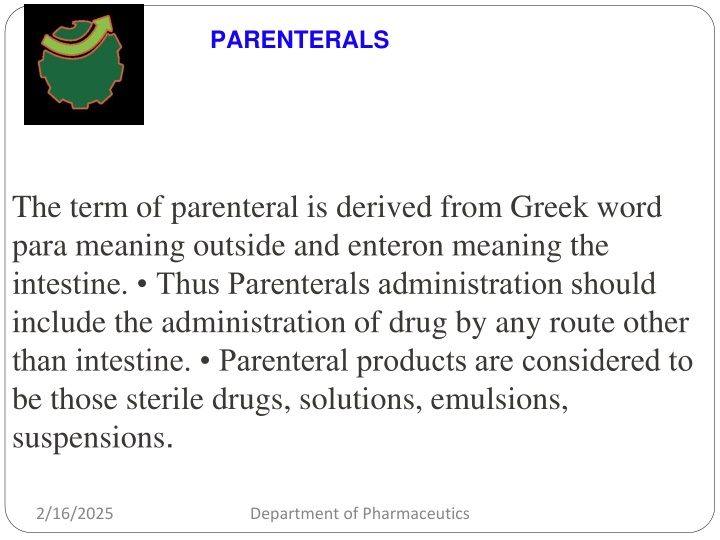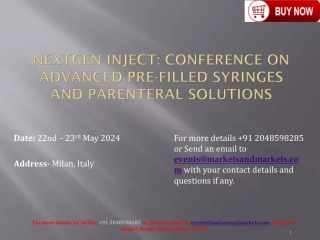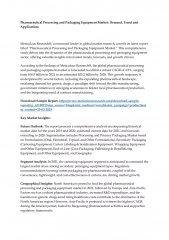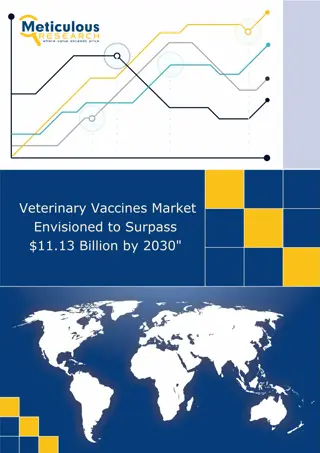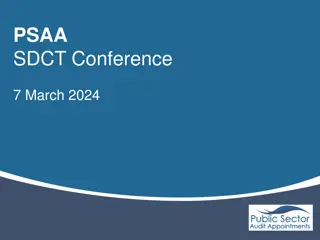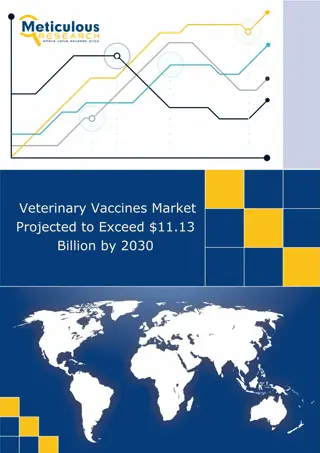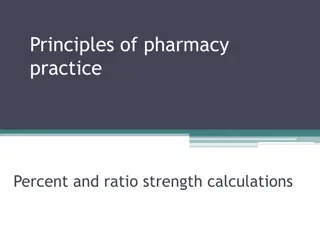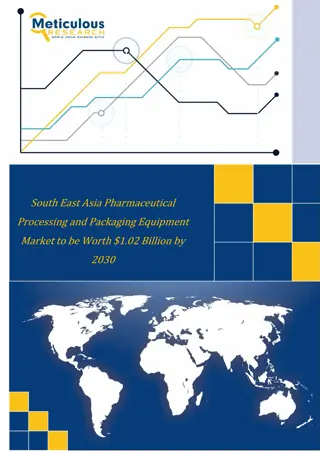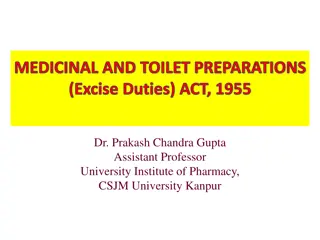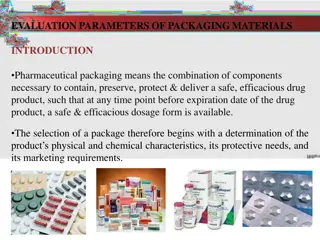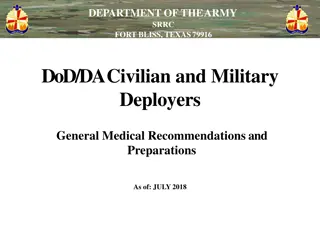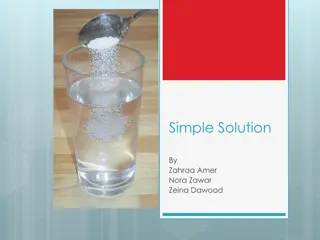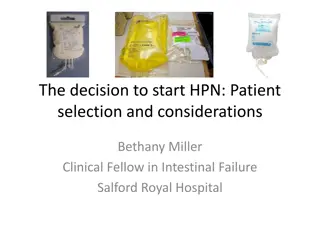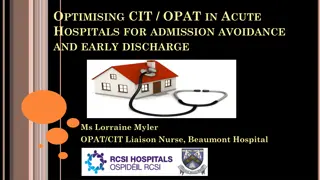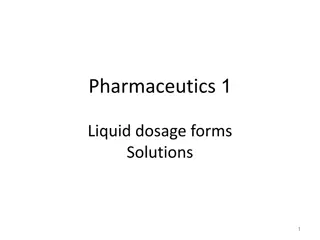Parenteral Preparations
Parenteral preparations are sterile products administered by injection, infusion, or implantation. They offer quick onset of action and are suitable for patients unable to take medications orally. While they have advantages, there are also disadvantages to consider. A focus on necessities like sterility, freedom from pyrogens, and clarity is crucial for their formulation. Different routes of administration and key components in the formulation process are also essential to understand in the realm of parenteral products.
Download Presentation

Please find below an Image/Link to download the presentation.
The content on the website is provided AS IS for your information and personal use only. It may not be sold, licensed, or shared on other websites without obtaining consent from the author.If you encounter any issues during the download, it is possible that the publisher has removed the file from their server.
You are allowed to download the files provided on this website for personal or commercial use, subject to the condition that they are used lawfully. All files are the property of their respective owners.
The content on the website is provided AS IS for your information and personal use only. It may not be sold, licensed, or shared on other websites without obtaining consent from the author.
E N D
Presentation Transcript
PARENTERALS The term of parenteral is derived from Greek word para meaning outside and enteron meaning the intestine. Thus Parenterals administration should include the administration of drug by any route other than intestine. Parenteral products are considered to be those sterile drugs, solutions, emulsions, suspensions. 2/16/2025 Department of Pharmaceutics
1. Definition: Parenteral preparations are sterile preparations containing one or more active ingredients intended for administration by injection, infusion or implantation into the body. They are packaged in either single-dose or multidose containers. 2/16/2025 Department of Pharmaceutics
Advantages: Quick onset of action. Suitable for the drugs which are not administered by oral route. Useful for unconscious or vomiting patients. Duration of action can be prolonged by modifying formulation. Suitable for nutritive like glucose & electrolyte. Suitable for the drugs which are inactivated in GIT or HCl (GI fluid). Bypass hepatic first pass effect. 2/16/2025 Department of Pharmaceutics
Dis-Advantages: Injections may cause pain at the site of injection Only trained person is required If given by wrong route, difficult to control adverse effect Sensitivity or allergic reaction at the site of injection 2/16/2025 Department of Pharmaceutics
Necessities of Parenteral preparations: Sterility (must) Free from Pyrogen (must) Free from particulate matter (must) Clarity (must) Stability (must) Isotonicity (should) 2/16/2025 Department of Pharmaceutics
Parental Routes of Administration 1. Subcutaneous 2. Intramuscular (IM) 3. Intravenous (IV) 4. Intra-arterial (IA) 5. Intrathecal 6. Intraarticular 7. Intrapleural 8. Intracardial 9. Intradermal 2/16/2025 Department of Pharmaceutics
Formulation of parenterals 1. Therapeutic agents 2. Vehicles Water Water miscible vehicles Non-aqueous vehicles 1. Added substances (Additives) Preservatives Solubilizing agents Tonicity-adjusting agents pH adjusting agent Antimicrobials Antioxidants Chelating agents 2/16/2025 Department of Pharmaceutics
THERAPEUTIC INGREDIENTS: a) Insulin, b) Antibiotics, c)Anticancer, d) Steroids, e) Vaccines, f) Antipyretic, g) Analgesics, h) Anti-inflammatory, i) LVP s like Dextrose, NaCl or combination etc. . 2/16/2025 Department of Pharmaceutics
. Water for injection (WFI): It is the water intended to be used in the manufacture of injectable products, which are to be sterilized after their preparation. It is the most frequently used solvent. It contains no added substances. It is prepared by distillation or reverse osmosis 2/16/2025 Department of Pharmaceutics
NONAQUEOUS SOLVENTS: NONAQUEOUS SOLVENTS: - - The main reasons for using non- aqueous vehicles are- Drug shows poor aqueous solubility. If prolonged/ sustained release of drug desired (Steroids). Drug susceptible to hydrolysis (Barbiturates). The solvents should be non-toxic, non-irritant, and inert The solvents should not exhibit any pharmacological activity of its own. The solvents should not influence the activity of medical agent. Examples: Fixed oils like Corn oil, Cotton seed oil, Peanut oil, Castor oils etc. 2/16/2025 Department of Pharmaceutics
WATER MISCIBLE VEHICLES: WATER MISCIBLE VEHICLES:- - (i) Alcohol- It is used as solvent and co-solvent. It is miscible with water and dissolves several water insoluble drugs (eg- Digoxin, Ergotamine). It also has preservative action. Disadvantages: (a) It causes pain and tissue damage, (b) Exhibit pharmacological activity and interfere with activity of main drug. 2/16/2025 Department of Pharmaceutics
Propylene Glycol- It is used for some particular drugs like Digoxin, Phenobarbitone. It is non toxic and water miscible. Disadvantages: Those injections by using this solvent should not be given through intramuscular and subcutaneous route, as it causes severe irritation. 2/16/2025 Department of Pharmaceutics
Preservatives: It is used to inhibit the growth of microorganisms. Used in Multidose containers and Single dose products that is not terminally sterilized. Preservative efficacy testing is done on proposed formulation to assure on effective preservative concentration. Examples: Benzalkonium chloride, Sodium benzoate 2/16/2025 Department of Pharmaceutics
Antioxidants: Antioxidants: by blocking an oxidative chain reaction. Certain antioxidants act as synergistic which increase the effectiveness of other antioxidants particularly those blocking reaction. Examples: Salts of Sulphur dioxide, including bisulphate, metabisulphite, are commonly used. Chelating agent: Chelating agent: They form complexes and inactivate metals such as iron and zinc that catalyze oxidative degradation of drug molecules. Examples: Edetate disodium, Citric acid and Tartaric acid. 2/16/2025 Department of Pharmaceutics
BUFFERS: PH of the formulation is maintained at the desired level by incorporating a suitable buffer. Eg: sodium citrate and sodium bicarbonate. Surfactants: These are used to disperse a water-insoluble drug to form a colloidal dispersion i.e, they enhance the solubility of the drug. Surfactants are mainly used in parenteral suspension and emulsions. Eg: polysorbate 80, propylene glycol. 2/16/2025 Department of Pharmaceutics
Tonicity contributors: Injections need to be isotonic with blood serum or any other body fluids. Tonicity adjustment is done using 0.9% NaCl, 2% boric acid. Preservative: These are the substances which prevent growth of microbes. Eg: benzalkonium chloride, metacresol,phenol etc 2/16/2025 Department of Pharmaceutics
Evaluation tests for parenterals 1.Leakage test: The leaker test is performed by immersing the ampoules in a dye solution, such as 1% Methylene blue, and applying a Vacuum (Negetive pressure) at least 27 inch Hg or more of vaccum is created for about15- 30 mins. This negetive pressure causes the methylene blue solution to enter the ampoules with defective sealing. The vacuum is released; ampoules are washed externally and observed the presence of dye in the ampoules. The presence of dye confirms the leakage. 2/16/2025 Department of Pharmaceutics
2. PYROGEN TEST: Preliminary test: If animals are used for the first time in a Pyrogen test or have not been used during the 2 previous weeks, condition them 1 to 3 days before testing the substance by injecting IV 10ml per kg pyrogen free saline solution warmed to about 38.5 Record the temperature of the animals, beginning at least 90 mins before injection and continuing for 3 hours after injection. Any animal showing a temperature variation of 0.6 or more must not be used in main test. 2/16/2025 Department of Pharmaceutics
Main Test: Insert a clinical thermometer into the rectum of each rabbit and normal reading of body temp. are taken prior to the injection of test solution. Two readings are taken at an interval of 30 mins and mean is calculated. This reading is the initial temp. of the rabbits. The test solution is injected into the ear vein of each rabbit. The volume of injection is 10 ml/kg and not less than 0.5ml/kg of body weight. 2/16/2025 Department of Pharmaceutics
Record the temperature of each animal at half-hourly intervals for 3 hours after injection. The difference between the initial temperature and the maximum temperature which is the highest temperature recorded for a rabbit is taken to be its response. Interpretation of Result Individual Temperature Temperature rise in No. of Rabbits Test rise ( c) groups ( c) 3 Rabbits 0.6 1.4 Passes If above not passes 3+5 =8 rabbits 0.6 3.7 Passes 2/16/2025 Department of Pharmaceutics
LAL (Limulus Amoebocyte Lysate)TEST /BACTERIAL ENDOTOXIN TEST This is a sensitive test used to detect endotoxins from gram-negetive bacteria. The endotoxins upon reaction with lysate from an insoluble gel clot. The lysate is obtained by the lysis of amoebocytes (blood cells) of the horseshoe crab, Limulus polyphemus. The addition of a solution containing endotoxins to a solution of a lysate produces turbidity, precipitation or gelatin of the mixture. 2/16/2025 Department of Pharmaceutics
PRINCIPLE The test is based on the formation of gel (or developmenyt of colour) in the presence of bacterial endotoxins and lysate solution. The lysate consists of proclotting enzyme and coagulogen (clottable protein) which are required for the reaction to occur. There are 3 types of LAL test: (i) The Gel Clot test: The lysate solution is mixed with an equal volume of test solution in a pyrogen free test tube. The test tube is allowed to stand for 60 minutes. Now the tube is inverted and observed for the formation of gel clot. The formation of solid gel confirms the presence of endotoxin. 2/16/2025 Department of Pharmaceutics
The Turbidimetric test: The test is based on the measurement of opacity change in the LAL test due to formation of gel clot. Opacity is directly proportional to the endotoxin concentration. The Kinetic Cromogenic test: It is based on the measurement of colour change which is caused by the release of chemical para-nitroanilide, which is a biproduct of clotting reaction during LAL test. The quantity of para-nitroanilide produced is directly proportional to the endotoxin concentration. 2/16/2025 Department of Pharmaceutics
. STERILITY TEST Sterility test is used to identify the presence or absence of viable microorganism in sterile preparations that are required to be sterile. The test is carried out under aseptic conditions to avoid contamination of the product during the test. The test is based on the principle that when micro-organisms are supplied with nutrient medium and water and incubated at favorable temperature, then the micro-organisms will multiply. The presence of micro-organisms can be identified by the turbidity in the clear medium. 2/16/2025 Department of Pharmaceutics
i) MEMBRANE FILTRATION METHOD: A membrane has a nominal pore size not greater than 0.45 and diameter of approximately 50mm. This method basically involves filtration of Sample through membrane filters. The filtration is assisted under Vacuum, after filtration completion the membrane is cut into 2 halves aseptically and one halve each is placed in two test tubes containing 100 ml of FTM and 100 ml of SCDM medium. Incubate the media- FTM (Fluid Thioglycollate Medium) at 20 c- 25 c and SCDM (Soyabean-casein Digest Medium) at 30 c- 35 c for not less than 14 days. 2/16/2025 Department of Pharmaceutics
(ii) DIRECT INOCULATION METHOD: It involves a direct inoculation of required volume of a sample in two tests tube containing a culture medium that is FTM, SCDM. If the test substance contains antimicrobial properties then it is neutralized by adding suitable inactivating substances to the medium. Volume of the preparation under examination is not more than 10% of the volume of the medium. 2/16/2025 Department of Pharmaceutics
Interpretation of results If the material being tested renders the medium turbid so that the presence or absence of microbial growth cannot be easily determined by visual inspection,14 days after the beginning of incubation, transfer portion (< 1 ml) of the medium to fresh vessels of the same medium and then incubate original and transfer vessel for not less than 4 days. If No evidence of microbial growth is found- complies with test for sterility. If evidence of microbial growth is found- does not comply with test for sterility. 2/16/2025 Department of Pharmaceutics
PARTICULATE TEST/ CLARITY TEST Particulate matter refers to the extraneous, mobile, undissolved particles, other than gas bubbles, unintentionally present in the solutions. Method A-Visual method: The filled containers are examined by holding the neck of the containers against strong illuminated screen. The containers are slowly inverted and rotated and the contents are examined for the presence of any foreign particles. Black surface is used for the detection of light colored particles and white surface for dark colored particles. If any foreign particle is visible, then that container is discarded. 2/16/2025 Department of Pharmaceutics
Method B-Microscopic particle count test: A measured sample solution is filtered through a membrane filter. The collected particles on the surface of the filter are then counted with the help of microscope at 100 X magnification. The whole method is carried out under aseptic condition. 2/16/2025 Department of Pharmaceutics
STERILIZATION: Sterilization is a physical method of microbial control by which an article, surface or medium is made free from all forms of viable microorganisms. 2/16/2025 Department of Pharmaceutics
Classification: 2/16/2025 Department of Pharmaceutics
AUTOCLAVE Strong metallic chamber made of stainless steel A cover fitted with steam vent , pressure gauze and safety valve Rubber gasket is fitted on inner side of the lid, in order to make autoclave airtight Cover is closed with wing nuts and bolts . The electrically heated element is fitted at the bottom to heat the water to convert into steam. The perforated inner chamber is placed on the stand . 2/16/2025 Department of Pharmaceutics
The material to be sterilised is loosely packed into it. A sufficient quantity of water is poured into the chamber after removing the perforated chamber. The level of the water is adjusted in such a way that it does not touch the bottom of the perforated chamber . The material is packed in the perforated chamber . The lid is then closed with wing nuts and bolts. 2/16/2025 Department of Pharmaceutics
The autoclave is switched on to heat the water. The vent is open and safety valve is set at the required pressure . When steam start coming out from the vent and it continues for 5 minutes, it is then closed. It indicates that air has been removed. The steam pressure start raising and it comes to the desired pressure i.e. 10 lbs/square inch with corresponding temperature 115 C or 15 lbs/ Sq.inch with corresponding temperature 121 C. Autoclave 2/16/2025 Department of Pharmaceutics
Tindalization: In this method, the solution to be sterilized is packed and sealed in its final container and heated at 80 C for one hour on each of three successive days . The first heating destroys the vegetative cells but not the bacterial spores. These bacterial spores germinate into the vegetative forms in the interval between the first and the second heating and are killed in the second heating . The third heating provides a safeguard against any spores which may not germinate until the second interval. 2/16/2025 Department of Pharmaceutics
Pasteurisation: Pasteurisation It is a partial sterilisation method which is used to make milk safe and also to improve its keeping properties. The process kills only 97 to 99 per cent microorganism, but it does not kill bacterial spores . 2/16/2025 Department of Pharmaceutics
HEATING WITH A BACTERICIDAL AGENT this sterilization method is suitable for injectables and is an official method in bp which has now been replaced by tyndalisation. 2/16/2025 Department of Pharmaceutics
HEATING WITH A BACTERICIDAL AGENT the procedure involves heating the parenteral solutions in their final containers at 90-100 for 30 minutes in boiling water or in steamer by adding a bactericidal agent . 2/16/2025 Department of Pharmaceutics
HEATING WITH A BACTERICIDAL AGENT however ,this method is not suitable for Parenterals used for intracisternal ,intrathecal or peridural administration ,as toxicity can be exhibited by the bactericidal agent . 2/16/2025 Department of Pharmaceutics
Sterilization by filtration Filtration is the process of separation of particulate matter from liquids and gases by allowing them to pass through a porous screen like material. It is a unique sterilization technique which unlike other sterilization processes is not destructive. 2/16/2025 Department of Pharmaceutics
Sterilization by filtration It actually removes the microbes by retaining them on the filter medium rather than destroying them. The principle application of this method is for the clarification and sterilization of thermolabile preparations such as injections, antibiotics, enzymatic preparations. 2/16/2025 Department of Pharmaceutics
Sterilization by filtration A wide variety of filters such as membrane filters, sintered glass filters, porcelain filters etc, each varying in their efficiencies pore size, mechanism and applications are used for the purpose of sterilization. 2/16/2025 Department of Pharmaceutics
GASEOUS STERILIZATION it is brought about with chemically reactive gases like ethylene oxide, formaldehyde, ozone etc. this method of sterilization is of particular importance in case of heat-sensitive materials. 2/16/2025 Department of Pharmaceutics
GASEOUS STERILIZATION ETHYLENE OXIDE: it is acyclic ether which is highest reactive and inflammable . it is availablele as a colourless liquid at temperatures below 10.8 degree centigrade. 2/16/2025 Department of Pharmaceutics
GASEOUS STERILIZATION it has remarkable property of penetrating through many packaging materials like plastic ,rubber ,paper board ,fabric thus achieving suitable concentrations in each article and resulting in efficient sterilization 2/16/2025 Department of Pharmaceutics
GASEOUS STERILIZATION MECHANISM OF ACTION: being an alkylating agent ,ethylene oxide causes alkylation of the sulfhydryl, amino ,hydroxy and carboxyl groups present on proteins and amino groups of microbial and ultimately microbial death. 2/16/2025 Department of Pharmaceutics
GASEOUS STERLIZATION FORMALDEHYDE: it is marketed as formalin which is 37% w/v aqueous solution of formaldehyde. formalin when heated to temp.. of 70-75 produces formaldehyde gas. which is used for sterilization. 2/16/2025 Department of Pharmaceutics
Radiation sterilization Depending on its intensity, wavelength and duration of exposure, radiation exerts various effects on microbial cells. Sterilizing radiations are of two types 1. Ionizing ( gamma rays and high energy photons) 2. non-ionizing (UV rays) 2/16/2025 Department of Pharmaceutics
Radiation sterilization 1. non-ionizing radiations: Mode of action: UV radiations causes excitation of atoms or molecules of nucleic acids to higher energy levels . This results in the generation of reactive chemical species which causes bonding b/w the adjacent pyrimidine bases. 2/16/2025 Department of Pharmaceutics
Radiation sterilization The thymine dimer so formed induces mutations in the DNA and inhibits correct DNA replication during cell reproductions. 2/16/2025 Department of Pharmaceutics
